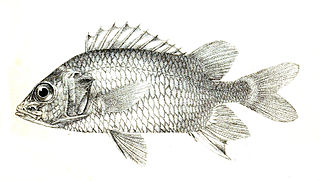
Aulostomus maculatus, the trumpetfish which is also known as the West Atlantic trumpetfish, is a long-bodied fish with an upturned mouth; it often swims vertically while trying to blend with vertical coral, such as sea rods, sea pens, and pipe sponges.

Pisces (♓︎) is the twelfth astrological sign in the Zodiac. It is a negative, mutable sign. It spans 330° to 360° of celestial longitude. Under the tropical zodiac, the sun transits this area between February 19 and March 20. In sidereal astrology, the Sun currently transits the constellation of Pisces from approximately March 12 to April 18. In classical interpretations, the symbol of the fish is derived from the ichthyocentaurs, who aided Aphrodite when she was born from the sea.

Holocentridae is a family of ray-finned fish, belonging to the order Beryciformes with the members of the subfamily Holocentrinae typically known as squirrelfish, while the members of Myripristinae typically are known as soldierfish. In Hawaii, they are known by the Japanese name mempachi/menpachi (メンパチ) or the Hawaiian ʻūʻū.

Sargocentron is a genus of squirrelfish found in tropical parts of the Indian, Pacific and Atlantic Oceans, with the greatest species diversity near reefs in the Indo-Pacific. Being largely or entirely nocturnal, they have relatively large eyes. Red and silvery colours dominate. The preopercle spines are venomous and can give painful wounds. Most have a maximum length of 15–25 cm (6–10 in), but S. iota barely reaches 8 cm (3 in), and S. spiniferum can reach more than 50 cm (20 in).

Sargocentron tiere or the blue-lined squirrelfish is one species of Squirrelfish from the Indo-Pacific. It occasionally makes its way into the aquarium trade. It grows to a size of 33 cm in length.

Sargocentron xantherythrum commonly known as Hawaiian squirrelfish or striped squirrelfish is a member of the squirrelfish family that is endemic to the Hawaiian Islands. It occasionally makes its way into the aquarium trade. It grows to a length of 17 centimeters (6.7 in).

Sargocentron diadema, known commonly as the crowned squirrelfish, is a member of the family Holocentridae in the order Beryciformes. Squirrelfish in general are large, active, nocturnal fish which are usually red in color.

Neoniphon is a genus of squirrelfishes.

Sargocentron spiniferum, common name sabre squirrelfish, giant squirrelfish and spiny squirrelfish, is a large Indo-Pacific species of squirrelfish belonging to the family Holocentridae.

Holocentrinae is a subfamily of Holocentridae containing 40 recognized species and one proposed species. Its members are typically known as squirrelfish and all are nocturnal. All three genera in the subfamily are found in the Atlantic and Holocentrus is restricted to this ocean. Most species in genera Neoniphon and Sargocentron are from the Indo-Pacific region and several of these occur in the Indian Ocean west of the southern tip of India.

Sargocentron rubrum, also known as redcoat, is a member of the family Holocentridae of the order Beryciformes. Squirrelfish in general are large, active, nocturnal fish which are usually red in color.

The redstripe pipefish is a fish from the genus Dunckerocampus.

Sargocentron punctatissimum is a species of fish related to the squirrelfish.

Sargocentron caudimaculatum, the silverspot squirrelfish, is a reef-associated member of the family Holocentridae. It is native to the Indian and Pacific Oceans from East Africa to Japan and northern Australia and as far east as the Marshall Islands. It lives near reefs, but can also be found in lagoons and drop-offs at depths between 2 and 40 metres. It is a nocturnal predator, feeding primarily on crabs and shrimps. It can reach sizes of up to 25.0 centimetres (9.8 in) TL. Although it is caught commercially and can be found in the aquarium trade, there are no known major threats to this species.
Sargocentron dorsomaculatum, also known as the spotfin squirrelfish, is a species of squirrelfish found in the western Pacific Ocean near the Ryukyu Islands, Pohnpei, Kosrae, the Caroline Islands, and Palau. It lives in shallow reefs at depths between 2 and 9 metres. Like other members of its genus, it is nocturnal and seeks shelter among corals and other structures. It can reach sizes of up to 19.7 centimetres (7.8 in) SL.

Sargocentron microstoma, the fine-lined squirrelfish, slender squirrelfish or smallmouth squirrelfish, is a member of the family Holocentridae. It has a wide range throughout the Indo-Pacific from the Chagos Archipelago, Seychelles, and the Maldives to the Hawaiian Islands, Line Islands, and the Tuamotus Archipelago, north to the Ryukyu Islands and Bonin Islands, south to Austral Islands and throughout Micronesia. It lives near reefs usually at depths between 1–35 m (3.3–114.8 ft), but can be found as deep as 183 m (600 ft). During the day it hides in crevices, especially near Acropora and Pocillopora. It is a nocturnal predator, feeding on crustaceans, worms, and fishes. It can reach sizes of up to 20 cm (7.9 in) TL and has a venomous preopercle.

Sargocentron spinosissimum is a species of fish in the squirrelfishes.
Sargocentron bullisi, more commonly known as the deepwater squirrelfish, is a nocturnal, reef-associated predator of the family Holocentridae. It is native to the West Atlantic from North Carolina, USA to southern Brazil and throughout the Caribbean Sea. It lives 33 to 110 metres below the surface. It can reach sizes of up to 13.0 centimetres (5.1 in) SL.

Sargocentron cornutum, the threespot squirrelfish, is a member of the family Holocentridae native to the western Pacific Ocean from Indonesia to the Great Barrier Reef. It lives in coral reefs and drop-offs between depths of 6–40 m (20–131 ft). It is a nocturnal predator, feeding on crabs and shrimps by night and hiding under ledges or in caves by day. It can reach sizes of up to 27.0 cm (10.6 in) TL and has a venomous preopercle.


















